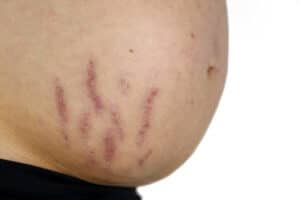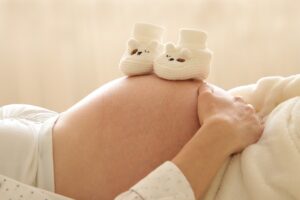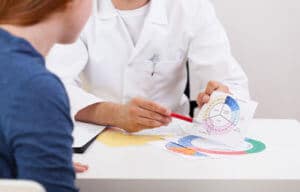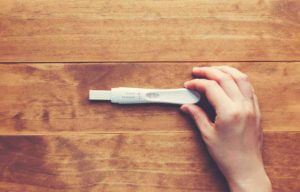Uterine prolapse occurs primarily in women after menopause. However, it can also be noticeable in younger women. Pregnancy and vaginal birth can increase the risk of uterine prolapse.
Everything you need to know about uterine prolapse can be found here.
Table of contents
What Is A Prolapse Of The Uterus?
A prolapsed uterus is a change in the position of the uterus. The uterus sinks because the pelvic floor is weakened. This can have various causes. Childbirth is also a possible cause.
Lower than usual, the uterus hangs in the pelvis. Prolapse or uterine prolapse is when the uterus enters or protrudes from the vagina.
In addition, the urinary bladder and bowel may descend and, in the worst case, bulge into the vagina.
The number of women affected by uterine prolapse is estimated by medical experts to be high. It is estimated at 30 to 50 percent. The number of those affected increases with age.
Most often, uterine prolapse occurs during or after menopause. Older women are much more likely to suffer from uterine prolapse, while it is rare in younger women.
The reason for this is the weaker connective tissue in older women. A prolapse of the uterus does not always cause symptoms. It can be completely asymptomatic.

Vaginal Prolapse And Prolapse Of The Vagina – Often Associated With Uterine Prolapse
In the case of vaginal prolapse, the vagina sinks downward. Vaginal prolapse is when parts hang out of the vagina. Vaginal prolapse or vaginal prolapse often occurs along with uterine prolapse.
Vaginal prolapse is noticeable with a foreign body sensation in the vagina and problems with urinary retention.
Symptoms Of Uterine Prolapse
Uterine prolapse does not always have to cause discomfort. If symptoms do occur, they depend on the severity of the uterine prolapse. The following symptoms may occur:
- Feeling of pressure or foreign bodies in the vagina.
- Back pain, especially in the lower back.
- Pulling in the lower abdomen.
- Abdominal pain up to the feeling that organs are falling out.
- Heaviness and pulling in the pelvis.
- Pain during sexual intercourse.
- In the case of prolapse, the uterus hangs out of the vagina.
Often, affected women sit with their legs crossed, fearing that something may fall out of the vagina.
Since the vaginal flora changes in the case of a prolapsed uterus, inflammation and mucous membrane deposits can occur in the vagina. If the uterine prolapse progresses further, pressure ulcers in the vagina and bloody vaginal discharge may occur.
Such discomfort is caused by mechanical irritation to the uterus. In prolapse, when the uterus is far forward in the vagina, vaginal closure is disturbed.
Different degrees of uterine prolapse
Uterine prolapse is classified into four degrees depending on its severity.
- 1. Grade – minor expression, which is often not noticed by the affected women.
- 2. Grade – uterus descends to the vagina.
- 3. Degree – uterus is already visible in the vagina.
- 4. Grade – complete prolapse with uterine and vaginal prolapse.
Pressure On The Urinary Bladder
Due to the changed position of the uterus, uterine prolapse may be accompanied by pressure on the urinary bladder.
Pain during urination, frequent urination with small amounts of urine, and a weakened urinary stream may result. If the uterine prolapse progresses further, urinary incontinence may result.
If urine leaks when coughing, sneezing or during physical exertion, this is called stress incontinence. Uterine prolapse may be associated with urinary tract infections.
In rare cases of prolapse, kidney congestion may occur. In most cases, treatment can then only be done with hysterectomy. Hysterectomy is also usually necessary when the uterus presses on the rectum.
There is often constipation and pain during bowel movements. In some cases, fecal incontinence with uncontrolled bowel movements may occur.
What Are The Causes Of Uterine Prolapse?
Uterine prolapse is caused by weakened pelvic floor muscles. Due to gravity, the uterus sinks downward, which can cause a pulling sensation in the abdomen.
The human pelvic floor is subjected to high stresses due to the upright gait. These stresses can be exacerbated by pregnancy and childbirth.
Pregnancy And Childbirth As Risks For Uterine Prolapse
Pregnancy creates a stretch in the muscles of the pelvic floor and throughout the abdomen that does not always fully recover. Some women may experience tearing and scarring of the muscles.
Pregnancy and childbirth do not always have to lead to uterine prolapse. There is an increased risk of uterine prolapse with multiple pregnancies, very heavy babies and a rapid birth sequence.
Vaginal birth, which is the normal case, has a higher risk of uterine prolapse. Unlike a cesarean section, vaginal birth puts more stress on the muscles and ligaments due to pushing and labor.
If uterine prolapse occurs after pregnancy or childbirth, hysterectomy is only necessary in exceptional cases.
Hysterectomy is performed only if the uterine prolapse causes a significant impact on the quality of life. Temporary uterine prolapse after childbirth is common and usually resolves itself.
Other Causes Of Uterine Prolapse
Here’s how uterine prolapse can be caused.
- Heavy lifting and carrying, which is associated with increased pressure in the abdomen.
- Chronic constipation.
- Frequent coughing or sneezing due to a respiratory condition.
- General weakness of the connective tissue.
- Obesity.
Connective tissue loses elasticity due to the normal aging process. Due to hormonal changes, most women experience mild uterine prolapse during menopause.
The loss of the female sex hormone estrogen during menopause also contributes to uterine prolapse. In rare cases, uterine prolapse can occur due to a congenital positional abnormality of the uterus.
Rarely, cancer of the pelvic floor is the cause of a descent. A risk factor for uterine prolapse is smoking.
Vaginal Prolapse After Hysterectomy
Women who have already had a hysterectomy may experience vaginal prolapse. The so-called vaginal blind sac remains after the hysterectomy.
If it was not adequately secured in the pelvis during surgery, it can sink downward due to gravity.
Diagnosis Of Uterine Prolapse
If you notice symptoms of uterine prolapse, you should consult a gynecologist. He will ask you about births, complaints and possible symptoms in an anamnesis interview.
During an examination he can assess the position of the reproductive organs and the pelvic floor. The doctor can determine whether pressure sores and inflammations have already occurred.
He can palpate the anus to see if the rectum is bulging. For examination, he can perform a cough test and determine if there is any leakage of urine. He can also detect a change in the position of the uterus.
If incontinence is also present, the doctor will measure the residual urine with an ultrasound examination. In addition, the bladder pressure can be measured.
A cystoscopy is also possible. It is done at least when a hysterectomy is necessary.
Treatment Of Uterine Prolapse
How uterine prolapse is treated depends on how advanced it is. Treatment can be conservative or surgical.
The doctor also decides on the basis of other complaints such as incontinence, and depending on the age and general condition of the patient, whether surgery is advisable. The desire to have children also plays a role in the decision about treatment.
Conservative Treatment Of Uterine Prolapse
Conservative treatment is used in cases of mild prolapse, minor incontinence and if the patient wishes to have children. An important starting point is the reduction of risk factors such as nicotine consumption, constipation or obesity.
In addition, it is important to avoid heavy lifting and carrying and to use certain techniques when lifting and carrying. Pelvic floor training plays an important role.
You need to do it consistently on a regular basis to prevent further progression of uterine prolapse and to achieve improvement. For conservative treatment, various devices can be prescribed, which can be inserted into the vagina by the doctor.
The uterus can be stabilized in position by pessaries. To prevent mucosal damage, treatment can be supported with estrogens. Estrogens are inserted into the vagina in the form of suppositories.
Treatment with estrogens in the form of suppositories or creams is primarily used for women in and after menopause. Conservative treatment requires regular check-ups.
Surgical Treatment Of Uterine Prolapse
If the uterine prolapse is far advanced, surgery is inevitable.Removal of the uterus is not necessary in every case. The pelvic floor muscles can be tightened.
In the process, the organs are returned to their original position. This surgery without hysterectomy can be done through the vagina, but also with an abdominal incision, similar to a cesarean section.
A vaginoplasty is used to strengthen the perineum. A distinction is made between anterior and posterior vaginoplasty.
Anterior vaginoplasty is required for bladder and vaginal prolapse, while posterior vaginoplasty is used when bowel prolapse has occurred.A hysterectomy is performed when there is no longer a desire to have children.
The remaining vaginal blind sac must be fixed in the pelvic cavity with a strip of tissue. Surgical treatment without hysterectomy can also be performed with a mesh inserted through the vagina between the bladder and the pelvic floor.
Consequences Of Surgical Treatment
To prevent recurrence of uterine prolapse after surgery, regular pelvic floor training is required. After surgery, patients may experience pain during urination and pain during sexual intercourse.
Such problems occur with overcorrection if the correction was done too intensively.
Uterine Prolapse And Childbearing
A prolapse of the uterus is not an obstacle to having children. Even if the descent is somewhat more pronounced, it does not stand in the way of a new pregnancy. However, the greater strain on the muscles can increase the symptoms.
Increased incontinence may occur with bladder weakness. Uterine prolapse does not pose an increased risk of miscarriage and complications during childbirth. To avoid increasing problems, an episiotomy may be performed at delivery.
After delivery, pelvic floor exercises and good postpartum gymnastics are important.
How You Can Prevent Uterine Prolapse
With regular pelvic floor training, but also with sports such as swimming, cycling or running, you can prevent a progression of the uterine prolapse or prevent a uterine prolapse.
Losing weight if you are overweight and avoiding heavy lifting and carrying are also useful. In addition, a healthy and balanced diet is helpful.
Lowering Of The Uterus: Conclusion
A prolapse of the uterus can have various causes. It usually occurs during or after menopause, as the connective tissue is weaker then.
Pregnancy or childbirth can also lead to a prolapse of the uterus, as the pelvic floor is then under greater strain. A prolapsed uterus makes itself felt with pulling in the lower abdomen, back pain, foreign body sensation in the vagina, and, in the case of prolapse, also with inflammation or pressure sores.
Treatment can be conservative or surgical. A hysterectomy is performed when surgical treatment is necessary and there is no longer a desire to have children. The uterine prolapse is not an obstacle to further pregnancy.
You can prevent uterine prolapse with consistent pelvic floor exercises.
Sources
https://www.netdoktor.de/krankheiten/gebaermuttersenkung
https://www.windeln.de/magazin/schwangerschaft/gesundheit/scheiden-und-gebaermuttersenkung.html












